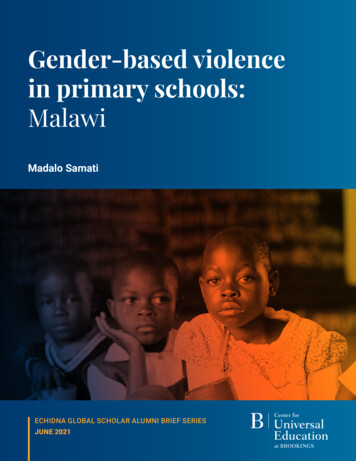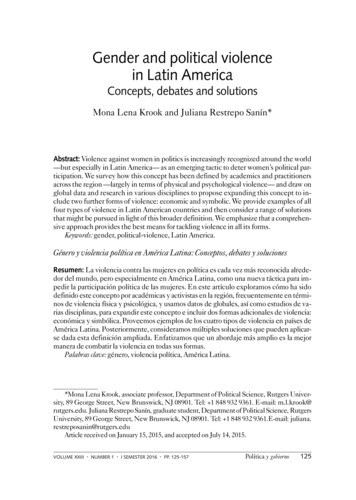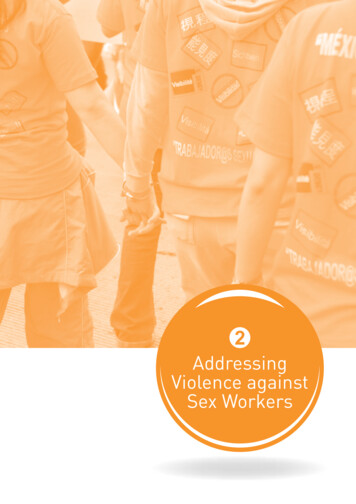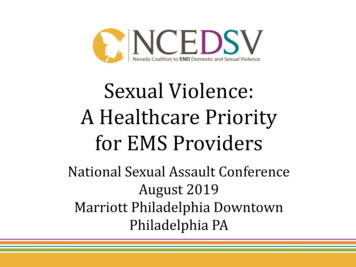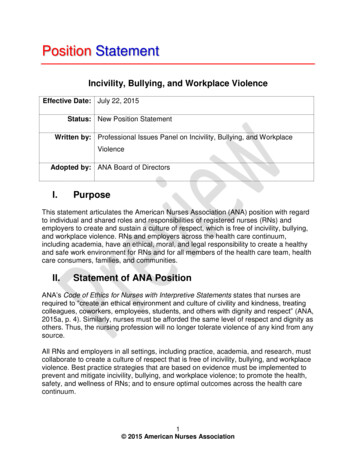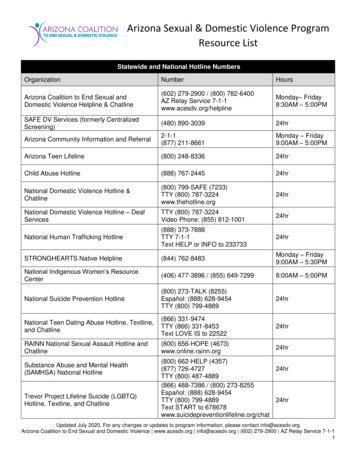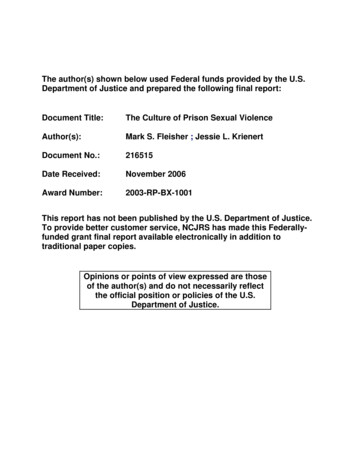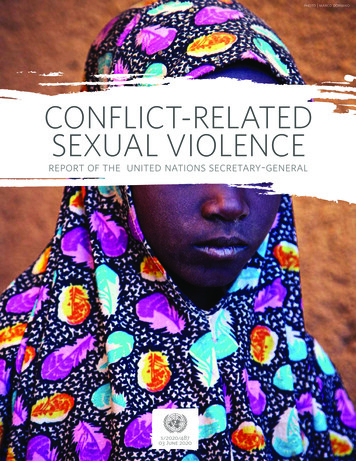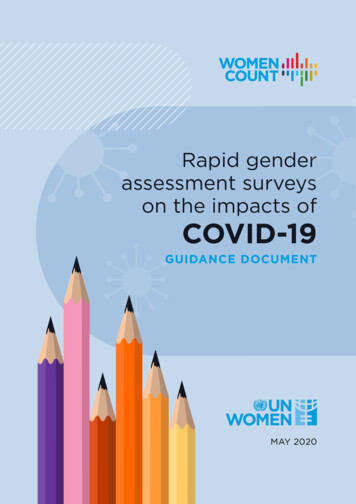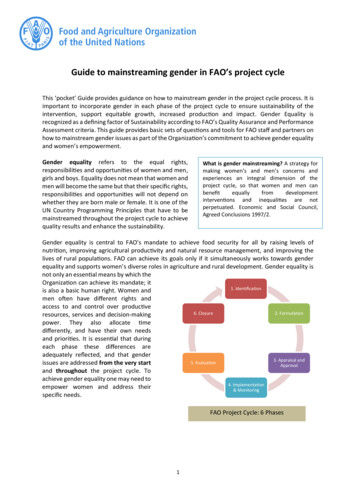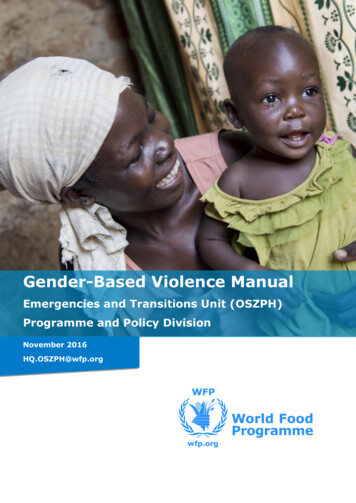
Transcription
Gender-Based Violence ManualEmergencies and Transitions Unit (OSZPH)Programme and Policy DivisionNovember 2016HQ.OSZPH@wfp.org
2
Table of ContentsAbout This Manual . 5Part 1: Introducing Gender-Based Violence . 71.1 Definition, causes and consequences of GBV . 71.2 Protection from Sexual Exploitation and Abuse (PSEA) . 81.3 WFP’s approach to GBV . 81.3.1 GBV as a protection and gender concern for WFP . 91.3.2 GBV and food insecurity . 91.3.3 The concentric circles model . 101.4 Policy Framework . 121.4.1 WFP’s commitment to GBV . 121.4.2 Policy on Humanitarian Protection . 121.4.3 Gender Policy 2015–2020 . 121.4.4 Commitment to Accountability to Affected Populations (AAP) . 121.4.5 Global Commitments . 12Part 2: Integrating GBV into WFP Operations . 152.1 GBV in the Project Cycle . 152.1.1 GBV analysis . 152.1.2 Project Formulation . 182.1.3 Project Review and Approval . 192.1.4 Project Implementation . 192.1.5 Monitoring and Reporting . 192.1.6 Evaluation. 202.1.7 Accountability to Affected Populations . 202.2 GBV in WFP Programmes . 212.2.1 General Distribution: selecting and implementing a GBV-sensitive transfermodality . 212.2.2 Livelihood, agriculture and market-access programmes . 252.2.3 School feeding . 292.2.4 Nutrition and HIV . 31PART 3: Addressing GBV Incidents through Referrals . 353.1 GBV referral methods . 353.2 GBV referrals in the WFP operational environment . 353.3 Developing a GBV Referral Strategy . 36PART 4: Advocacy and Partnership . 394.1 Advocacy . 394.2 Partnerships. 403
4
About This ManualWhat is it?This manual provides an overview of the key issues related to gender-based violence(GBV) in the context of WFP’s operations. It seeks to guide staff and partners so they canbetter identify and respond to GBV risks related to hunger and nutrition and to WFPprogrammes.In particular, the guidance aims to identify practical steps to ensure that WFP staff areable to: Understand what GBV means;Understand how GBV is relevant to WFP;Conduct GBV analysis in order to identify GBV-related threats, vulnerabilities,capacities, gaps and opportunities;Apply specific measures to prevent, mitigate and respond to GBV threats within thecontext of WFP’s activities;Identify opportunities to address GBV through food assistance, thereby achieving adual objective of food security and protection;Monitor GBV risks in the operational context;Refer GBV survivors to appropriate service providers in a safe and ethical way; andManage GBV case reporting in a safe and ethical way.Who is it for?This guidance is intended to reach all WFP staff and partners. It is especially important forthose who are involved in one or more steps of WFP’s programme cycle, includingmanagers, programme officers and field monitors.How should it be used?The guidance should be used as a reference tool for integrating GBV as a protectionconcern into WFP operations. It does not provide a comprehensive overview of all typesof GBV risks. Rather, it serves to guide staff through the process of identifying relevantGBV risks in their operational country context. It is ultimately up to WFP staff to determinehow to adapt and apply the guidance to their situation. This guidance should be reviewedbefore planning, implementing and monitoring programmes and field activities.StructureThe guidance is divided into the following sections:Part 1 Introducing GBV Introduces the broader concept of GBV, explains WFP’sapproach to GBV, and provides the policy framework for GBV as a protection concern forWFP.Part 2 Incorporating GBV in WFP Operations Outlines how to conduct a GBV analysis,explains incorporation of GBV in the programme cycle and provides a generic GBV riskanalysis for each modality and programme type.Part 3 Addressing GBV Incidents Through Referrals Outlines the process by whichWFP staff should refer protection and GBV incidents that go beyond their expertise orcapacity to respond; andPart 4 Advocacy, Partnerships and Coordination Explains GBV advocacy, introduceskey actors and partners in GBV, and highlights key interagency monitoring and reportingmechanisms.5
6
Part 1: Introducing Gender-Based Violence1.1 Definition, causes and consequences of GBVThe IASC Guidelines for Gender-based Violence Interventions in Humanitarian Settingsdefines gender-based violence as “an umbrella term for any harmful act that is perpetratedagainst a person’s will, and that is based on socially ascribed (gender) differences betweenmales and females”1.Gender-based violence (GBV) is a widespread phenomenon that exists in all societies andcontexts around the world, regardless of religion, ethnicity, socio-economic status or levelof education. Although forms and prevalence of GBV vary across cultures, countries andregions, GBV is a serious human rights violation and a potentially life-threateningprotection issue that disproportionately affects women and children.The common GBV categories are physical, sexual, economic, psychological/emotionalabuse/violence, and harmful practices. Some of the more common examples of GBVinclude: sexual violence, sexual exploitation and/or abuse (SEA), domestic violence,trafficking, forced and/or early marriage, and other traditional practices that cause harmsuch as female genital mutilation, honour killings and widow inheritance.2Gender-based violence is a consequence of deep-rooted socio-cultural beliefs and practicesthat attach specific roles, responsibilities, behaviours, expectations, opportunities andlimitations to being a woman and to being a man. These norms create unequal powerrelationships between men and women that, in the majority of cases, results in thesubordination of women, as well as discriminatory and restrictive notions of masculinityand femininity. Socio-cultural norms around the roles and the position of men vis-à-viswomen also contribute to a distorted perception of what is considered a violation.Sometimes norms instil a generalised acceptance of some forms of violence. For example,in some contexts rape is considered a major humiliation for the survivor and a minoroffence for the perpetrator, and in some countries marital rape is a criminal offence whilein other countries it is not. Likewise, domestic violence is often considered a private matterin which outsiders should not interfere. These societal norms reduce the likelihood ofreporting and access to justice for the survivors, as well as lead to a culture of impunitythat is, in turn, a contributing factor to the increased likelihood of GBV.From its theoretical beginnings GBV was synonymous with violence against women andgirls, although over time the definition of GBV has been used to highlight certain forms ofviolence against men and boys. Prevalence rates for sexual violence against men can bemore difficult to determine: men and boys may be less inclined to expose what hashappened to them due to entrenched gender norms, cultural and religious taboos and illequipped services3.The term gender-based violence also applies to violence perpetrated against lesbian, gay,bisexual, transgender and intersex persons that is “driven by a desire to punish those seenas defying gender norms”4.In emergencies, whether natural disaster or conflict, GBV tends to be more prominent dueto a range of factors, including disintegration of state power and control, breakdown ofcommunity and household networks, the use of rape as a weapon of war, widespreadInter-Agency Standing Committee (IASC). 2015. “Guidelines for Integrating Gender-Based ViolenceInterventions in Humanitarian Action”.2GBV AoR (2010) Handbook for Coordinating Gender-Based Violence Interventions in Humanitarian Settings.3UNHCR, Working with Men and Boy Survivors of Sexual Violence and Gender-Based Violence, Need to KnowGuidance4Office of the High Commissioner for Human Rights (OHCHR). 2011. ‘Discriminatory Laws and Practicesand Acts of Violence Against Individuals Based on Their Sexual Orientation and Gender Identity17
impunity, pervasive discriminatory cultural norms, and shifting gender roles that arise insituations of increased poverty, insecurity and displacement.Gender-based violence has serious consequences, including immediate injury and possiblelong-term physical and psychosocial harm, as well as social and economic consequencesand death. Children who witness violence are more likely to have emotional andbehavioural problems, perform poorly in school and be at risk of perpetrating orexperiencing violence in the future. Indirect impacts on individual and communityproductivity can lead to increased poverty and undermine potential economic and socialdevelopment, creating a cycle of underdevelopment, poverty and violence. All of theseconsequences can have a critical impact on people’s food security and nutritional status.1.2 Protection from Sexual Exploitation and Abuse (PSEA)Sexual exploitation and abuse (SEA) is a form of GBV and, within the United Nationssystem, refers to acts committed by aid personnel against affected populations. SEAviolates universally recognized human rights. SEA also undermines the relationship of trustbetween an organization and the people it seeks to serve. SEA represents a failure of theUnited Nations to protect vulnerable people and jeopardizes the reputation of the UnitedNations at large.The United Nations has adopted a zero tolerance policy against sexual exploitation andabuse (SEA). This is outlined in the 2003 Secretary-General’s Bulletin on SpecialMeasures for Protection from Sexual Exploitation and Sexual Abuse(ST/SGB/2003/13)(The SGB).5 The SGB relates PSEA specifically to theresponsibilities of international humanitarian actors to prevent incidents of sexualexploitation and abuse committed by United Nations, non-governmental organization(NGO) and inter-governmental personnel against affected populations. The SGB highlightsthe responsibility of humanitarian actors to take prompt action when incidents occur. TheSGB applies to all United Nations staff and related personnel, to all categories of UnitedNations peacekeeping personnel, as well as to non-United Nations entities or individualsin a cooperative agreement with the United Nations. WFP has reaffirmed its commitmentto protection from SEA with four Executive Director Circulars issued since 2005, the latestin 2014. These circulars outline specific measures WFP staff at both Headquarters and fieldlevels must take to prevent SEA in WFP operations.Sexual exploitation and abuse is not to be confused with sexual harassment,6 whichrefers to “any unwelcome and unwanted sexual advances, requests for sexual favours,or other unwelcome or unwanted written, verbal or physical conduct of a sexual nature”.It is associated with the workplace and occurs between employees. At WFP, sexualharassment is covered by the Policy on Harassment, Sexual Harassment and Abuse ofAuthority.1.3 WFP’s approach to GBVWFP’s operational contexts are sometimes characterised by a high prevalence of GBV, bothin development and, particularly, in crisis settings. WFP has both an ethical obligation anda programmatic interest in taking GBV into account when planning, implementing andmonitoring its operations. In addition, as a large humanitarian actor with a significant fieldpresence, WFP staff may witness or come into contact with GBV issues. In this instance,Secretary-General’s Bulletin on Special Measures on Protection from Sexual Exploitation and Abuse. New York:UN Secretariat. ST/SGB/2003/13, section 3.26WFP has a Policy on Harassment, Sexual Harassment and Abuse of Authority. It can be found at the followinglink: /documents/cd/wfp236761.pdf58
WFP must ensure that its staff are able to deal with the affected person(s) in a safe andethical way and refer them to the most appropriate actors for assistance and follow-up.WFP’s approach to GBV mirrors the broader approach to protection set forth in the Policyon Humanitarian Protection, which defines protection as “designing and carrying out foodand livelihood assistance activities that do not increase the protection risks faced by thecrisis-affected populations receiving assistance, but rather, contribute to the safety,dignity and integrity of vulnerable people”.WHAT DOES PROTECTION MEAN FOR WFP?Safety, dignity and integrity are key elements of WFP’s definition of protection andshould be understood in the following way: Safety: from injury, violence, coercion, deprivation, or the threat of any of these. Dignity: self-determination, respect for aspirations and wishes, self-worth. Integrity: respecting the full spectrum of people’s needs, rights and capacities; andnot discriminating on the ground of race, ethnicity, religion, gender, sex, politicalaffiliation, etc.1.3.1 GBV as a protection and gender concern for WFPGender-based violence is recognized as both a protection and gender concern. As requiredby the Protection Policy, Gender Policy and in accordance with the “do no harm” approach,WFP programmes and interventions must not create, exacerbate or contribute to genderinequality or discrimination and must mitigate risks of GBV.When planning short- and medium-term emergency responses where GBV is recognizedas a serious and widespread protection issue, the immediate response falls within theimplementation of the Protection Policy.In order to address the root causes of GBV, longer-term planning with a more concertedapproach to promoting gender equality and women’s empowerment is required. Theimplementation of the Gender Policy is key in achieving this.1.3.2 GBV and food insecurityIt is important to note that WFP can only play a role in addressing protection concerns thatare connected to food insecurity, as these can be influenced by food assistanceinterventions.Since 2005, within the framework of the broader in-house protection discourse, WFP hasbeen exploring the linkages among food insecurity, food assistance and GBV throughextended field research and consultations with protection partners. In 2010, WFP engagedin a series of field studies aimed at “Enhancing prevention and response to sexual andgender-based violence in the context of food assistance in displacement settings”. Thisguidance builds on the findings of those studies, among other sources.The links between GBV and food insecurity are clear. GBV can increase levels of hungerand malnutrition by affecting people’s degree of access to and control over food. Forexample, poor families may sacrifice female children’s nutrition in order to meet the needsof male children. Additionally, people who have been exposed to GBV may sufferpsychosocial or physical harm, stigma and exclusion, and consequently be unable togenerate income and care for their dependants. In many contexts, women’s lack of accessto and control of assets, services and income increases their economic dependence as well9
as their vulnerabilities to abusive and exploitative situations. These factors can lead tofood insecurity.WFP recognizes its responsibility to: Assume that gender-based violence is taking place;Treat it as a serious and life-threatening protection issue; andTake actions to minimize the risk of gender-based violence through its interventions,regardless of the presence or absence of concrete evidence.For more information, refer to IASC GBV Guidelines and the GBV AoR Handbook forCoordinating GBV Interventions in Humanitarian Settings.Food insecurity may exacerbate some forms of GBV. For example, women and girls whoare traditionally tasked with finding fuel to prepare food, may need to venture to unsafeareas to collect firewood and be exposed to risk of assault. Within households, domesticviolence can rise during periods of food scarcity, and may decline as assistance fills thefood gap. Women heads of households may engage in transactional sex to be able to meetfood needs, and parents may push for early marriage for their daughters in the hope theywill have their food needs met elsewhere.Food or cash assistance in itself may also unintentionally contribute to GBV. A fooddistribution site that is located in an unsafe area, or is far from where people live, mayexpose women to sexual violence. Cash delivered to women without taking intoconsideration gender roles and responsibilities may unintentionally increase domesticviolence in a society that is strictly opposed to women having control over economicresources.1.3.3 The concentric circles modelWFP sees protection as a corporate cross-cutting issue that informs all aspects of itsresponse. WFP’s mandate and expertise defines what this means at different operationallevels. The scope of WFP’s role in addressing GBV as a protection concern can be illustratedby the following concentric circles model.Protection issues in thebroader operational contextProtection issues relatedto food insecurityProtection concernsin WFP operationsInner circle: Protection concerns in WFP’s operationsThe inner circle refers to protection concerns directly related to food assistance activitiescarried out by WFP and its partners. WFP needs to implement its programmes in a waythat does not exacerbate existing GBV risks or create additional ones. WFP has theobligation to take all possible measures to prevent and/or react to any GBV risk arisingfrom its activities and presence on the ground.10
Example: Managing risks at distribution sites in South SudanIn South Sudan, WFP has considered protection concerns, such as distance, cultural andphysical barriers and insecurity, when selecting programme implementation sites. In theearly stages of the crisis, for example, WFP only distributed milled and blendedcommodities due to fears that women could be attacked if they were forced to leave thesites in search of milling facilities. Generally, distribution sites are selected based onwhether they provide shelter from harsh weather conditions, water can be provided, anda gender-balanced crowd-control staff is employed.Middle circle: Protection issues related to food securityThis circle refers to protection concerns that contribute to or are exacerbated by foodinsecurity. It is important for WFP to engage and actively identify opportunities forsupporting protection outcomes through food assistance.Example: Safe houses in the Democratic Republic of the CongoWFP provides food for survivors of sexual violence who are recovering in Panzi Hospital,in Bukavu, in the Democratic Republic of the Congo. Rape is widespread in the country,particularly in the war-torn east of the country. Many of the women come from remoterural areas and know no one in Bukavu to cater for their needs. WFP’s food assistance isvital and enables women to stay for the time that is recommended for recovery. Womenparticipate in workshops on life skills, and sessions on psychosocial care are available inPanzi Hospital. The skills they learn while staying in hospital give them a greatercapacity to earn a living once they return home.Outer circle: Protection issues in the broader contextWFP staff may witness or in other ways come into contact with GBV issues that go beyondtheir capacity and expertise to respond. Regardless of whether or not these issues relateto food insecurity or WFP’s operations, WFP must ensure that its staff are able to deal withthe affected persons in a safe and ethical way and report them to the most appropriateactors for follow-up and assistance.When possible, WFP can conduct advocacy. WFP should cooperate with protection andother humanitarian actors to use its leverage to advocate for the rights of the affectedpopulation. In situations where WFP is the only United Nations presence, WFP can advocatewith protection actors to strengthen presence and develop responses to protection issuesoccurring on the ground.Example: Referral cards for Syrian refugeesAs part of the response to the Syrian refugee crisis, WFP has developed a businesscard-size Protection Issue Referral Card designed for staff to carry in their wallet.Although WFP does not deal directly with GBV cases, WFP staff receive training on howto deal with cases that are presented to them in the field. The Protection Issue ReferralCard is designed to help WFP staff respond in a way that links individuals at risk to themost appropriate care quickly, compassionately and professionally.11
1.4 Policy Framework1.4.1 WFP’s commitment to GBVBecause of their central importance in WFP, both gender and protection are corporatecross-cutting issues that need to be integrated into all aspects of WFP’s work. WFPrecognizes that GBV results from gender inequalities and treats it as a life-threateningprotection issue. WFP takes measures to minimize the risk of GBV occurring through itsprogramme interventions. WFP’s specific commitment to GBV is outlined in both the Policyon Humanitarian Protection and the Gender Policy. In addition, a number of policyframeworks and corporate commitments help define WFP’s role in addressing GBV as aprotection concern.1.4.2 Policy on Humanitarian ProtectionIn 2012, WFP adopted the Policy on Humanitarian Protection, which sets forth WFP’scommitment to address protection issues within its operations and to maximise theprotective impact of its presence and activities. The Policy on Humanitarian Protectionmakes reference to gender and GBV. It highlights the importance of making programmaticchoices through a protection lens. This guidance is part of the operationalization of theHumanitarian Protection Policy.1.4.3 Gender Policy 2015–2020The goal of the Gender Policy is to enable WFP to fully integrate gender equality andwomen’s empowerment in all of its work and activities in order to ensure that the differentfood security and nutrition needs of women, men, girls and boys are addressed. WFP’sgender approach requires taking account of other social dimensions such as age, sexualorientation, religion, ethnicity and disability status, which can also impact food securityand nutrition.1.4.4 Commitment to Accountability to Affected Populations (AAP)In line with the Protection Policy, WFP endorsed the five IASC commitments to ensuringaccountability to affected populations (AAP). An AAP approach reinforces and complementsprotection by providing methodologies for understanding and mitigating protectionconcerns.To operationalise its AAP commitments, WFP focuses on three areas that it considers keyto facilitating greater communication with and participation by affected populations:1. Information Provision;2. Consultation; and3. Complaints and Feedback Mechanisms (CFMs).Each of these elements is relevant when addressing GBV, as each one contributes todeveloping a better understanding of the GBV risks that affected people are exposed toand can help identify appropriate responses.For more information, see section 2.1.7 Accountability to Affected Populations.1.4.5 Global CommitmentsAt the global level, through its work on protection of civilians, the United Nations SecurityCouncil has recognized the centrality of women, peace and security by adopting a seriesof thematic resolutions (1325, 1889 and 2212 on women, peace and security broadly;1820, 1888, 1960 and 2106 on women’s participation, and, more specifically, on conflictrelated sexual violence). Also, the 2005 Security Council Resolution 1612 established amonitoring and reporting mechanism (MRM) on six grave violations against children inarmed conflict, including rape and sexual violence against children.12
The Convention on the Elimination of All Forms of Discrimination against Women (CEDAW),adopted in 1979 by the United Nations General Assembly, is often described as aninternational bill of rights for women. Consisting of a preamble and 30 articles, it defineswhat constitutes discrimination against women and sets up an agenda for national actionto end such discrimination.Launched in 2008, the United Nations Secretary-General’s UNiTE to End Violence againstWomen Campaign aims to raise public awareness and increase political will and resourcesfor preventing and ending all forms of violence against women and girls in all parts of theworld. WFP is committed to actively participate every year in the UNiTE 16-Days ofActivism Campaign to end violence against women and girls (from 25 November to 16December). WFP’s participation includes advocacy to prevent, mitigate, respond anderadicate gender-based violence within its mandate. The theme colour is orange, andmultiple initiatives are developed by the country office, regional bureaux and Headquartersto celebrate the “Orange Campaign” and the “Orange Days” on the 25th of every month.In November 2013, the Department for International Development launched the “Call toAction on Protection from Gender-Based Violence in Emergencies”. The objective of theinitiative is to mobilize donors, United Nations agencies, NGOs and other stakeholders toestablish a framework for accountability and action to address GBV in emergencies. Withinthis framework WFP committed to take actions to enhance its efforts to prevent andrespond to GBV.In 2015, the updated IASC Guidelines for “Integrating Gender-Based ViolenceInterventions in Humanitarian Settings” were published. The purpose of these guidelinesis to assist humanitarian actors and communities affected by armed conflict, naturaldisasters and other humanitarian emergencies to coordinate, plan, implement and monitoractions for the prevention and mitigation of GBV across all sectors of humanitarianresponse. This guidance follows a similar operational approach.13
14
Part 2: Integrating GBV into WFP Operations2.1 GBV in the Project CycleIn order to ensure programmes and interventions do not create, exacerbate or contributeto perpetuating gender inequalities or discrimination, GBV protection considerations mustbe integrated throughout the programme cycle. When looking at the project cycle withinthe concentric circles model, you will be focusing on the Inner circle: protectionconcerns in WFP’s operations and also considering the Middle circle: protectionissues related to food security.This section presents concepts and practical recommendations that are applicable to alltypes of programmes. Further considerations specifically tailored for each programme andtransfer modality are developed in section 2.2.2.1.1 GBV analysisAddressing GBV requires a comprehensive understanding of the operational context, witha particular focus on its socio-cultural dimensions, and reflecting this analysis in WFPprogrammes.BE PRACTICAL Essential GBV risk-reduction measures can and should be introducedregardless of a formal GBV analysis. Common sense and basic goodprogramming principles should guide WFP staff in identifying thesemeasures. For example: Ensure that food distribution points are placed in safe, accessible locations;and Schedule distributions at times that are accessible and safe for any at-riskgroups.Therefore, a GBV analysis, incorporating elements of both protection and gender, needsto be carried out at the onset of programme planning, throughout implementation and aspart of monitoring.What to analyseIn general, an analysis aimed at gathering relevant GBV information should identify anddocument GBV and include the following key questions:GBV analysis What GBV risks are people exposed to (e.g. sexual violence, sexual exploitation,trafficking, transactional sex, forced prostitution, denied access to education, harmfulpractices, economic violence, domestic violence, restrictions on mobility, physicalabuse)? Who is affected and how? Men, women, boys and girls, different age groups, ethnicgroup
9 WFP must ensure that its staff are able to deal with the affected person(s) in a safe and ethical way and refer them to
